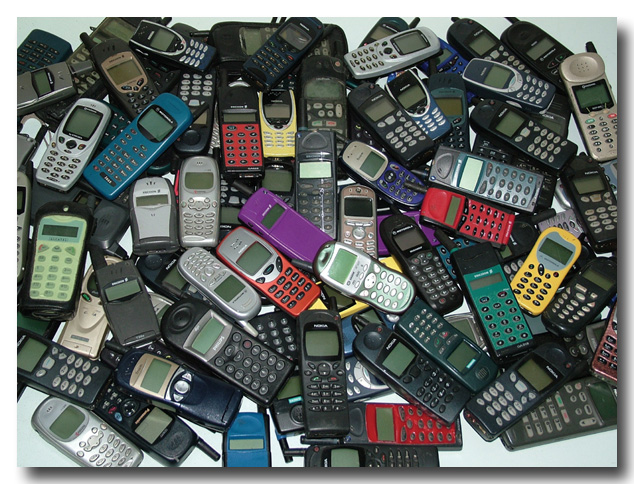
Millions of people around the world use cellular phones. They are such great gadgets you can talk to anyone on the planet from just about anywhere! These days, cell phones provide an incredible array of functions, and new ones are being added at a breakneck pace. Depending on the cell-phone model, you can:
• Store contact information
• Make task or to-do lists
• Keep track of appointments and set reminders
• Use the built-in calculator for simple math
• Send or receive e-mail
• Get information (news, entertainment, stock quotes) from the Internet
• Play games
• Watch TV
• Send text messages
• Integrate other devices such as PDAs, MP3 players and GPS receivers
But have you ever wondered how a cell phone works?
To start with, one of the most interesting things about a cell phone is that it is actually a radio -- an extremely sophisticated radio, but a radio nonetheless. In the dark ages before cell phones, people who really needed mobile-communications ability installed radio telephones in their cars. In the radio-telephone system, there was one central antenna tower per city, and perhaps 25 channels available on that tower. This central antenna meant that the phone in your car needed a powerful transmitter -- big enough to transmit about 70 km. It also meant that not many people could use radio telephones -- there just were not enough channels. The genius of the cellular system is the division of a city into small cells. This allows extensive frequency reuse across a city, so that millions of people can use cell phones simultaneously. A good way to understand the sophistication of a cell phone is to compare it to a CB radio or a walkie-talkie.
• Full-duplex vs. half-duplex - Both walkie-talkies and CB radios are half-duplex devices. That is, two people communicating on a CB radio use the same frequency, so only one person can talk at a time. A cell phone is a full-duplex device. That means that you use one frequency for talking and a second, separate frequency for listening. Both people on the call can talk at once.
• Channels - A walkie-talkie typically has one channel, and a CB radio has 80 channels. A typical cell phone can communicate on 1,664 channels or more!
• Range - A walkie-talkie can transmit about 1.6 km using a 0.25-watt transmitter. A CB radio, because it has much higher power, can transmit about 8 km using a 5-watt transmitter. Cell phones operate within cells and can switch cells as they move around. Cells give cell phones incredible range. Someone using a cell phone can drive hundreds of miles and maintain a conversation the entire time because of the cellular approach.

In half-duplex radio, both transmitters use the same frequency. Only one party can talk at a time.
In full-duplex radio, the two transmitters use different frequencies, so both parties can talk at the same time.
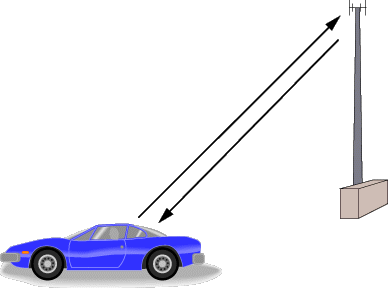
Cell phones are full duplex.
In a typical analog cell-phone system the cell-phone carrier receives about 800 frequencies to use across the city. The carrier chops up the city into cells. Each cell is typically sized at about 26 square kilometers. Cells are normally thought of, as hexagons on a big hexagonal grid, like this:

Because cell phones and base stations use low-power transmitters, the same frequencies can be reused in non-adjacent cells. The two purple cells can reuse the same frequencies.
Each cell has a base station that consists of a tower and a small building containing the radio equipment. We'll get into base stations later. First, let's examine the "cells" that make up a cellular system.
A single cell in an analog cell-phone (1G) system uses one-seventh of the available duplex voice channels. That is, each cell (of the seven on a hexagonal grid) is using one-seventh of the available channels so it has a unique set of frequencies and there are no collisions:
• A cell-phone carrier typically gets 832 radio frequencies to use in a city.
• Each cell phone uses two frequencies per call -- a duplex channel -- so there are typically 395 voice channels per carrier. (The other 42 frequencies are used for control channels -- more on this later.)¬Therefore, each cell has about 56 voice channels available. In other words, in any cell, 56 people can be talking on their cell phone at one time if the cell runs out of channels no new calls can be made until one is freed up, the phone will show no signal and will not call out. Analog cellular systems are considered first-generation mobile technology, or 1G. With digital transmission methods (2G), the number of available channels increases. For example, a digital system can carry three times as many calls as an analog system, so each cell has about 168 channels available. ¬ Cell phones have low-power transmitters in them. Many cell phones have two signal strengths: 0.6 watts and 3 watts (for comparison, most CB radios transmit at 4 watts). The base station is also transmitting at low power. Low-power transmitters have two advantages:
• The transmissions of a base station and the phones within its cell do not make it very far outside that cell. Therefore, in the figure above, both of the purple cells can reuse the same 56 frequencies. The same frequencies can be reused extensively across the city.
• The power consumption of the cell phone, which is normally battery-operated, is relatively low. Low power means small batteries, and this is what has made handheld cellular phones possible.
The cellular approach requires a large number of base stations in a city of any size. A typical large city can have hundreds of towers. But because so many people are using cell phones, costs remain low per user. Each carrier in each city also runs one central office called the Mobile Telephone Switching Office (MTSO). This office handles all of the phone connections to the normal land-based phone system, and controls all of the base stations in the region.
Cell Phone Codes
Electronic Serial Number (ESN) - a unique 32-bit number programmed into the phone when it is manufactured
Mobile Identification Number (MIN) - a 10-digit number derived from your phone's number
System Identification Code (SID) - a unique 5-digit number that is assigned to each carrier by the ACMA
While the ESN is considered a permanent part of the phone, both the MIN and SID codes are programmed into the phone when you purchase a service plan and have the phone activated. the codes are most offen programed into your sim card
All cell phones have special codes associated with them. These codes are used to identify the phone, the phone's owner and the service provider.
Let's say you have a cell phone, you turn it on and someone tries to call you. Here is what happens to the call:
• When you first power up the phone, it listens for an SID on the control channel. The control channel is a special frequency that the phone and base station use to talk to one another about things like call set-up and channel changing. If the phone cannot find any control channels to listen to, it knows it is out of range and displays a "no signal" message.
• When it receives the SID, the phone compares it to the SID programmed into the phone. If the SIDs match, the phone knows that the cell it is communicating with is part of its home system.
• Along with the SID, the phone also transmits a registration request, and the MTSO keeps track of your phone's location in a database -- this way, the MTSO knows which cell you are in when it wants to ring your phone.
• The MTSO gets the call, and it tries to find you. It looks in its database to see which cell you are in.
• The MTSO picks a frequency pair that your phone will use in that cell to take the call.
• The MTSO communicates with your phone over the control channel to tell it which frequencies to use, and once your phone and the tower switch on those frequencies, the call is connected. Now, you are talking by two-way radio to a friend.
• As you move toward the edge of your cell, your cell's base station notes that your signal strength is diminishing. Meanwhile, the base station in the cell you are moving toward (which is listening and measuring signal strength on all frequencies, not just its own one-seventh) sees your phone's signal strength increasing. The two base stations coordinate with each other through the MTSO, and at some point, your phone gets a signal on a control channel telling it to change frequencies. This hand off switches your phone to the new cell.
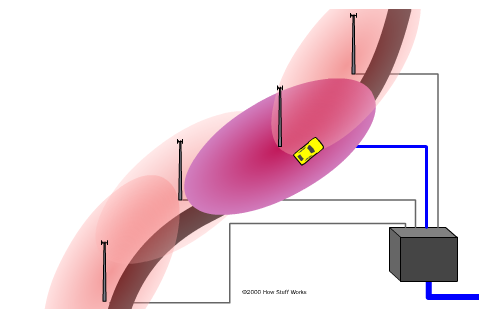
Let's say you're on the phone and you move from one cell to another -- but the cell you move into is covered by another service provider, not yours it drops the call unless you are using roaming. If the SID on the control channel does not match the SID programmed into your phone, then the phone knows it is roaming. The MTSO of the cell that you are roaming in contacts the MTSO of your home system, which then checks its database to confirm that the SID of the phone you are using is valid. Your home system verifies your phone to the local MTSO, which then tracks your phone as you move through its cells. And the amazing thing is that all of this happens within seconds. The less amazing thing is that you may be charged insane rates for your roaming call. On most phones, the word "roam" will come up on your phone's screen when you leave your provider's coverage area and enter another's. If not, you'd better study your coverage maps carefully -- more than one person has been unpleasantly surprised by the cost of roaming. Check your service contract carefully to find out how much you're paying when you roam.
Note that if you want to roam internationally, you'll need a phone that will work both at home and abroad. Different countries use different cellular access technologies.
First Generation Mobile phones (1G)
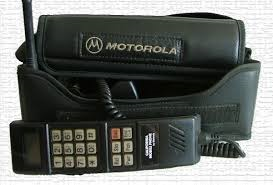
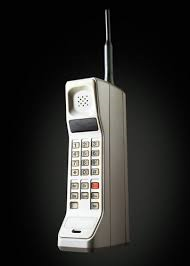
1G Phones are often called analogue cell phones, Telstra made the first 1G system in February 1987 in Sydney this was first modern cell phone system in Australia it quickly spread across populated areas of Australia. Analogue cell phones are were not able to send any txt’s / data or internet information, they were also very expensive at around $4.000 when the network was first started but the price of the hand set soon dropped, early 1G phones were large and cumbersome some the size of hand bags while others were the size of bricks which gave rise to the term “brick phone’ the 1G system become very popular and Telstra was soon running out of analogue channels to carry the calls in highly populated areas resulting in towers often filling up and people no longer being able to make calls. A security issue also soon appeared as it was found that people with radio scanners were able to ease drop on conversations of others using cell phones. Analogue cell phone are now days a thing of the past and confined to museums and dusty draws.
Second Generation Mobile phones (2G)
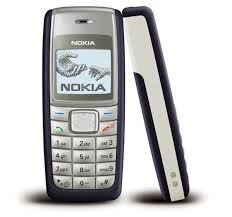
Second Generation or 2G phones or digital cell phones as they came to be called are still in use by sum providers today and are often sold under the name of GSM phones as well as digital but only time will tell how long they last with the increasing spread of newer systems (The Telstras 2G GSM Network Closed on 2/12/2015). 2G phones removed the analogue component of the cell phone system allowing allot more channels with in the limits of the old 1G system they are also secure and hard to ease drop on. With the newer digital system txt and short message services became available. As a stop gap step in the late 90’s Telstra setup a service called CDMA which used both 1G and 2G to keep services running as they upgraded the network to run 2G, CDMA phones would switch between 1G and 2G depending on what system was available were they were located. CDMA like the 1G network has now been shut down. In the early 2000’s As the internet become more popular people started to want to check their emails and view web site while out and about, the 2G system is slow to pass data such as videos and music so another upgrade was needed
Third Generation Mobile phones (3G) / Next G

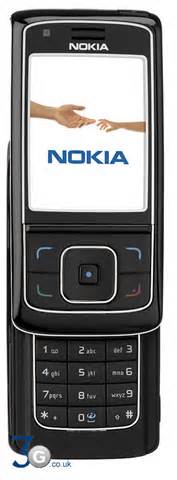
Third Generation phones build on the advances of the 2G phones by adding more computing power and using newer software and programming to allow faster data rates over the phone system. A 3G phone now has more computing power than a desk top computer from the 80’s . The biggest advantage of the 3G system is the adding of internet on your phone. The only down side is that with this new speed the amount of towers to provide it must increase resulting In more towers being installed in high traffic areas the range of the phone is also reduced due to the complexity of the signals it is sending. The speed of the data also reduces with the distance you are from the tower. Most 3G phones will drop back to a 2G system in the absence of high speed signals. 3G phone are currently the stranded hand set modal in Australia. With 3G came the advent of picture messaging and video calling both are yet to take off in any big way.
Forth Generation Mobile phones (4G) and beyond
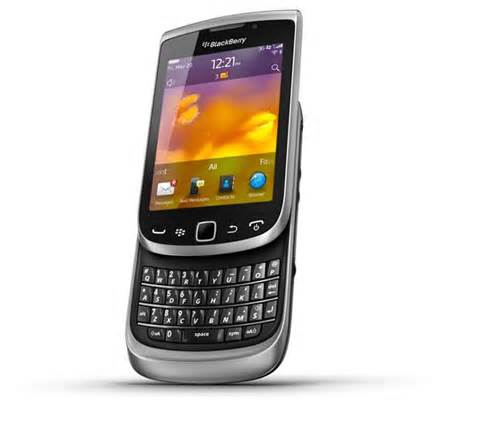
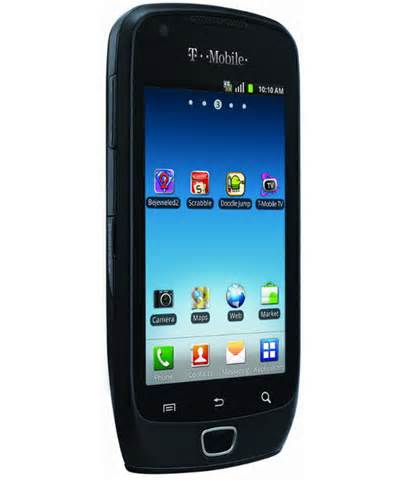
Forth Generation phones and another step forward providing more data speed and more computing power the direction phones are taking at the time of publishing mobile phone companies are trying to deliver ever faster data services to users it is expected that the speed of phone data will continue to increases and as a extra add on to make phone calls to. Most phone net works are trying to make 4G networks at this time but most are concentrated to major cities and region centers
Inside a Digital Cell Phone
2G and above phones convert your voice into binary information (1s and 0s) and then compress it. This compression allows between three and 10 digital cell-phone calls to occupy the space of a single analog call. Let's take a good look inside a digital cell phone On a "complexity per cubic area" scale, cell phones are some of the most intricate devices people use on a daily basis. Modern digital cell phones can process millions of calculations per second in order to compress and decompress the voice stream.
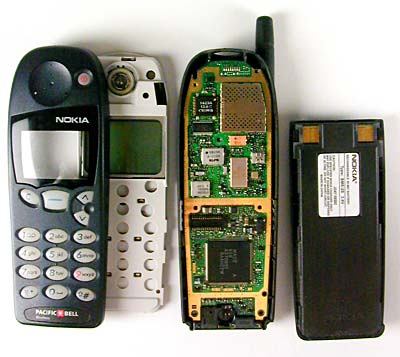
If you take a basic digital cell phone apart, you find that it contains just a few individual parts:
• An amazing circuit board containing the brains of the phone
• An antenna
• A liquid crystal display (LCD)
• A keyboard (not unlike the one you find in a TV remote control)
• A microphone
• A speaker
• A battery
The circuit board is the heart of the system. Here is one from a typical Nokia digital phone:
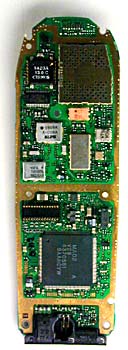
The front of the circuit board
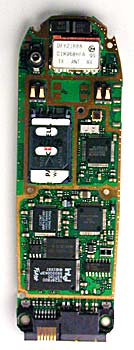
The back of the circuit board
Cell-phone Towers
A cell-phone tower is typically a steel pole or lattice structure that rises 10’s of meters into the air. This cell-phone tower near a freeway
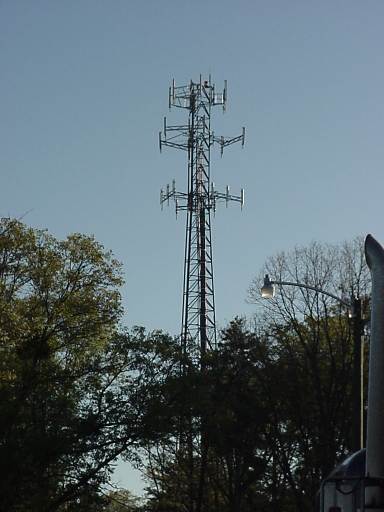
This is a modern tower with three different cell-phone providers riding on the same structure. If you look at the base of the tower, you can see that each provider has its own equipment, and you can also see how little equipment is involved today (older towers often have small buildings at the base):
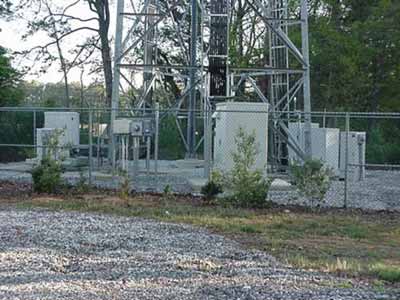
Here is the equipment owned by one of the providers:
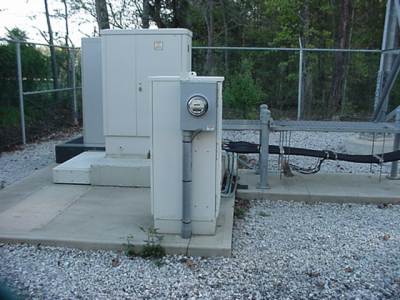
The box houses the radio transmitters and receivers that let the tower communicate with the phones. The radios connect with the antennae on the tower through a set of thick cables:
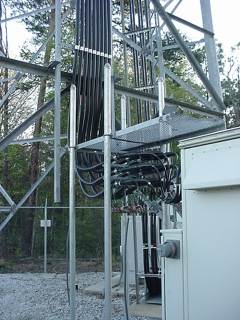
If you look closely, you will see that the tower and all of the cables and equipment at the base of the tower are heavily grounded. For example, the plate in this shot with the green wires bolting onto it is a solid copper grounding plate:
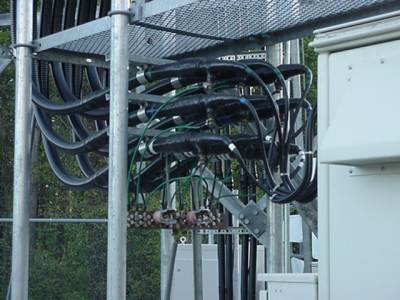
One sure sign that multiple providers share this tower is the amazing five-way latch on the gate. Any one of five people can unlock this gate to get in.
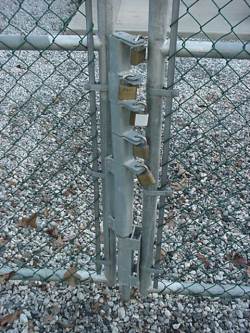
Cell-phone towers come in all shapes and sizes, but I do believe this one in Morrisville, North Carolina, is one of the weirdest looking.
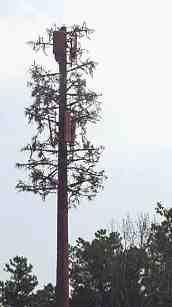
That is one tall, ugly tree!
Table 12 Pros and Cons of Mobile Phones
| Pros |
Cons |
| Portable device |
Must be within 25 Km of a tower |
| Low cost of Equipment |
Can have infrastructure damaged and be affected by wether |
| Easy to use |
Subject to network congestion |
| Texting |
Medium call costs |
|
Medium cost Medium speed internets |

Tips when calling Triple Zero (000) or (112)
1. Stay Calm.
2. You will be asked if you require police, fire or ambulance. Select the service you require.
3. You will then be connected to an emergency call operator who will ask you a series of questions.
4. If you are on a mobile phone you will be asked to provide the Town and State details of the Emergency. This ensures you are connected to the correct locality for response.
5. It is vital to ensure that the correct information is provided so that the emergency service requested can attend your situation.
It is important to remember that the questions are asked to provide you with the best and fastest service for your needs. In time-critical situations the emergency services are being dispatched while you are being questioned. Your information will continue to be updated throughout the call.
Using your mobile in an emergency
When possible, it's recommended that you contact Emergency Services by calling Triple Zero (000) from a Land line.
At any one time, network capacity, topography, climate and even the number of users in a particular location, can affect your ability to make a call in an emergency using a mobile. That's why it's best not to rely on your mobile as the only way to communicate. So, if circumstances require it, consider carrying a specialised emergency communication device such as an HF, VHF or UHF radio, or a satellite phone/ ERIRB’S. It's important to remember that the number to call in an emergency situation depends on whether your mobile uses the GSM or Next G™ network.
If you have a GSM / Next G™ mobile
To get help from police, fire or ambulance services in Australia, dial '000' or '112'. Contact can even be made if your mobile has been blocked or your security settings have been activated.
You can still attempt a normal '000'emergency call from a GSM or Next G™ mobile but if you do not have reception with your own carrier, you can dial '112' and your call will be carried by any available network if it is available.